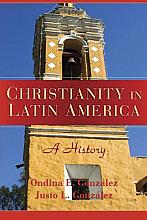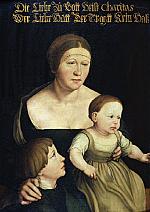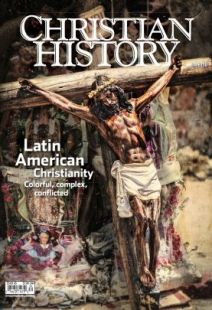Rooted and released
Where is Latin American Christianity today? We sat down with issue advisors uncle and niece Justo L. González and Ondina E. González, co-authors of Christianity in Latin America and Nuestra Fe. Ondina is an independent scholar and co-edited Raising an Empire. Justo, a United Methodist minister, has taught at the Evangelical Seminary of Puerto Rico and Candler School of Theology and has written many books including A History of Christian Thought and The Story of Christianity.
Christian History: Is it even possible to make generalizations about Latin American Christianity?
Justo L. González: Like any other human situation, it is very complex. But the two faces of the church from the colonial period still exist—a focus on liberation versus a focus on institution—in every main expression of faith. Catholics are divided between those concerned about liberation theology and those interested in institutional power. . . . In mainline Protestant churches, there’s a great deal of work in social service, social justice, and critique of the social order, but another branch of those churches says, “We’re supposed to save souls, make people holy, and stay out of the temporal world.”
In Pentecostalism there’s been huge growth in the prosperity gospel, which preaches that God will give material prosperity as a sign of divine favor—as in Brazil with the enormously wealthy Igreja Universal do Reino de Deus, controlled by one man. But other Pentecostals are becoming more engaged in social movements.
Ondina González: I recently met a couple from Mexico who have moved to Macon, Georgia, and started an Asambleas (Assemblies) church to minister to the local Latino population.
JG: There are Brazilian missionaries in Africa and Australia, and Korean missionaries in Argentina.
OG: Latin America received all these missionaries and now has turned around and is sending out missionaries. And among those are a lot of women.
CH: Say more about women in leadership today.
OG: In Catholic churches there are women in leadership but not at the top of the hierarchy. It’s been that way for a long time.
JG: In most countries there’s been a shortage of Catholic priests; maybe one for 50,000 believers. Laymen don’t think the church is masculine. Women fill the gap. Whole parishes are run by women. They don’t say Mass, but they preach. The priest comes occasionally and consecrates elements to be distributed later by the women, who also hear confession but don’t give absolution.
OG: After the Mexican Revolution, the state turned against the church and the church suspended the administration of sacraments. Priests and monastics were run out of town, but laywomen held clandestine meetings and led clandestine Bible studies.
Later women were active in base communities. I think women have always been there; numbers aren’t greater today, but woman leaders may be more visible.
JG: In Latin America leadership has to do with class as much as gender. Being a woman may be much less important than being rich and having prestige. The Catholic Action movement was led by damas encopetadas (ladies with fancy hairdos).
OG: Well-heeled, we’d say in English.
JG: Very often the conflict between parish priests and base communities is also a conflict of gender between male priests and women leading base communities.
OG: Women grapple very differently with poverty, public health for children, and education for children. When you’re fighting for your children, you tend to fight a lot harder than for yourself, whether you are male or female; in Latin America females traditionally have had the most responsibility for children.
JG: Because of the freedom of the Spirit, many Pentecostal churches have been founded and led by women, but sometimes don’t ordain women when they organize formally. In the United States, beginning in the 1970s, there was a great push to ordain women. My wife and I went to a meeting of Latin American bishops and noticed that in the US people argue women have a right to be ordained. [Catherine Gunsalus González is professor emerita of church history at Columbia Theological Seminary and a Presbyterian minister.—Editors] In Latin America they argue that people have a right to ministry, so we must allow women to minister. That reflects ideas of liberation theology.
OG: It also reflects the idea of community. The community has a right to be ministered to. . . . It’s interesting to me that a growing percentage of the population is not affiliated with a church or has multiple religious affiliations. A Brazilian might practice Candomblé, but also belong to a Catholic church.
JG: [Yet] there are more deeply committed believers in every church. When I was growing up as a Protestant in Cuba, theoretically just about everyone was Catholic, but hardly anyone was a practicing Catholic. Today there are fewer Catholics, but they are really Catholic.
OG: In Cuba for a long time to be a member of a church was a serious political risk. But eventually the state turned to the churches to provide health care and aid during crises because churches had set up networks of care and support despite that risk. It’s very similar to the early church. Christianity spread because early Christians saw people in need and helped them.
CH: What are some trends in modern worship?
JG: When I was growing up, my Catholic friends would say, “I’m going to hear Mass.” The obligation was to hear it, not participate. I think that has changed, with Mass in the vernacular, and the cup returned to the laity. Now people often go to the Protestant church to hear and follow along with a band making some contemporary music. The active role of the laity in worship is diminished. There are even some leaders who give themselves the title “worshiper.”
OG: Some churches are trying to reclaim pre-Columbian elements, using indigenous instruments in music or giving corn a prominent role. It asserts cultural identity by going back to a pristine Latin America—well, not pristine—
JG: Older? In Guatemala there are divisions between those who want to use corn and fire and dance and those who say “This is heathen” and give resistance.
OG: The colonial Catholic Church tried to extirpate anything that reminded people of past worship practices. But the second and third generations after conquest apparently didn’t see contradictions.
JG: There have been recent finds of little indigenous images hidden in fifteenth- and sixteenth-century Catholic altars. So when people were kneeling, who were they kneeling to?
OG: When it comes to actual practices, there’s still a high level of devotion to the saints, which has a long tradition and is also part of popular culture.
JG: This is how religions cross in Latin America. Every Voodoo, Candomblé, or Santería god is associated with a saint. Santa Barbara, patron saint of gunners and artillery, is also the Santería god of thunder. A saint may be associated with an Indian tradition, a Catholic tradition, and an African tradition. Sometimes this disturbs outsiders, even the same people who have egg hunts and bunnies on Easter Sunday. I think we all tend to mix traditions. We recognize it only when other people do it. CH
By the editors with Justo L. González and Ondina E. González
[Christian History originally published this article in Christian History Issue #130 in 2019]
Next articles
Latin America: Recommended resources
Here are recommendations from CH editorial staff and this issue’s authors that begin to explore the complex subject of Latin American Christianity.
the editorsEditor's note: Women of the Reformation
Enter the fifth issue in our four-issue Reformation series.
Jennifer Woodruff TaitSupport us
Christian History Institute (CHI) is a non-profit Pennsylvania corporation founded in 1982. Your donations support the continuation of this ministry
Donate






